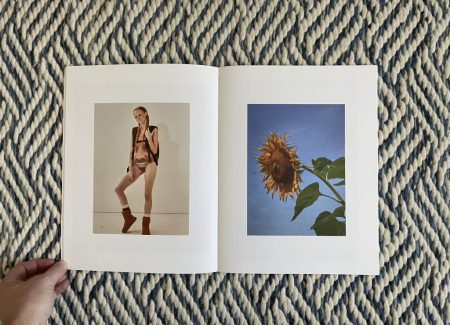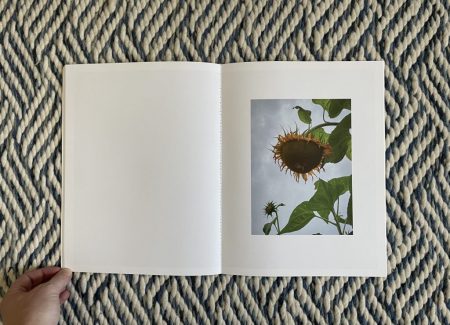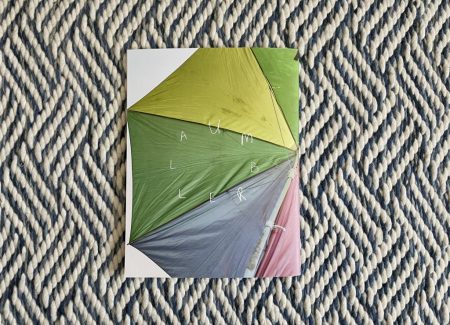JTF (just the facts): Self-published in 2020 by Polychronic (here). Sewn-bound softcover, 11.8 x 9.8 inches, 40 pages, with 43 color reproductions. Includes an explanatory text by the artist and a page of stickers. In an edition of 250 signed copies. (Cover and spread shots below.)
Comments/Context: The unsettled, deliberately uncertain tone of Roe Ethridge’s photography feels like a perfect match for our dark stuck-in-a-pandemic mood. We’re living through a time of sustained upheaval, where everything feels off-kilter and far from normal, and it’s only natural for us to turn an increasingly jaundiced eye toward even the most mundane of our daily routines. Throughout his photographic career, Ethridge has surfed the edge of this kind of disruption, constantly testing our assumptions for how certain categories of images are supposed to look or function. And in the context of the pandemic, his eye for inversion and dissonance seems even more archly incisive.
As its title implies, the most prominent subject matter in Beach Umbrella is in fact beach umbrellas that Ethridge found discarded on Rockaway Beach in July of 2020, just a few days after New York City beaches reopened to the public this past summer. Ethridge attributes the discovery of so many broken and left over umbrellas to the intense pent up pandemic demand for time outside in the sunshine that New Yorkers were feeling, and for the impulse to drag out underused supplies (like beach umbrellas) which had been lurking in storage closets across the city. He writes that his trips to the beach had “that semi-apocalypse vibe that permeates nowadays,” but were “joyful in an archaeological way.”
Alternately posed with a deflated yellow volleyball, a pair of rubber flip-flops, and some discarded packs of cigarettes (like commercial setups gone bad), the umbrellas are generally seen in their toppled over state, with Ethridge’s camera looking up underneath to the bent poles and supporting metal ribs. The fabric panels that make up the umbrellas generally sport rainbow or palm tree motifs in a range of sunny colors, and Ethridge’s compositions make the most of their interior geometries. A few images play with double exposures, and a few more seem drawn to the imperfections of rough use, but for the most part, there aren’t an infinite number of ways to photograph a beach umbrella, and Ethridge has largely opted for those that highlight repetitions of color and triangular arrangement. The best of the pictures crop away the surrounding sky, leaving us cocooned within shimmering panels of bright color.
Intermingled among the umbrellas are images from two other recent projects. One starts with a neglected school garden in Clinton Hill, and emerges with a series of tightly framed portraits of drooping sunflowers. Here again, Ethridge is knowingly playing with symbols, intentionally pushing against the usual expectation that a sunflower will be reaching upward toward the sun. While he hasn’t chosen examples that have fallen into full decay, like his image “Old Fruit”, the blooms are sagging and bent over, looking down rather than up.
The other project draws from a fashion commission Ethridge did for Document Journal in 2018, where the editorial theme was “summer for winter.” It too offers a puzzling turnabout, mixing the extremes of summer and winter clothing into integrated looks. A pink nose covering and an over the shoulder beach chair accessorize a swimsuit and huge red fur overcoat combination, while sunglasses and a plastic cooler add summer vibes to a wetsuit and trenchcoat ensemble. Perhaps the strangest look pairs thick socks and Uggs with a swimsuit with what looks like the artist’s bearded face printed on it, creating a disconcerting face over body mixup. Ethridge has often hijacked the styles of fashion photography and rearranged them in new ways, and this set of pictures certainly undermines what we think we know about seasonal dressing.
When shuffled together, the three bodies of work complement each other surprisingly well. In unpacking and undermining just a few of the tropes of summer, Ethridge has made the season feel slightly uneasy, and the jumbled fashions only reinforce the sense that we’re all a bit disoriented at the moment. Beach Umbrella isn’t a major statement photobook – but it delivers its message with photographic bite and intelligence. It’s a child of the pandemic, one that indirectly captures our mood of dispirited fatigue.
Collector’s POV: Roe Ethridge is represented by Andrew Kreps Gallery (here) and Gagosian Gallery (here) in New York. Ethridge’s work has become more available in the secondary markets in recent years, with prices ranging between roughly $5000 and $35000.




















